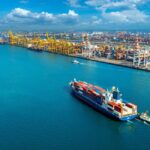Today, we discuss a topic that involves almost all spheres of the macro world of logistics. In fact, it is probably one of the subjects that, more than many others, is perceived as crucial by all the players involved. International shipping represents a critical element for companies operating on a large scale. However, behind every shipment that crosses borders and oceans lies a series of unexpected costs and logistical risks that can significantly impact profit margins. Customs delays, documentation errors, unforeseen storage expenses, and sudden tariff increases are just some of the pitfalls that can affect an international transportation operation. How can these issues be proactively addressed? In this article, we will explore the main risks and unexpected costs in international shipping and, in addition, provide useful tips for optimizing logistics.
Main risks in international shipping
One of the most common obstacles in global shipping concerns incomplete or incorrect documentation. Each country has specific regulations, and the absence of a necessary form or an incorrect customs code can result in significant delays and financial penalties. In other words, a simple oversight in goods classification can inflate import costs or even block the shipment at customs for days or weeks.
Another critical factor is inadequate packaging. Goods must be protected not only from shocks and vibrations during transport but also from atmospheric agents. Insufficient packaging can lead to damaged goods and, consequently, returns, claims, and additional costs for product replacement.
Unexpected delays are another frequent problem in international shipping. The causes can be multiple: adverse weather conditions, port strikes, maritime traffic congestion, or technical issues with carriers. Even meticulous planning may not be enough to prevent such unforeseen events, but risk management strategies can help mitigate their impact.
Finally, companies often face hidden costs and unexpected surcharges. These can include unexpected customs duties, surcharges for shipping to remote areas, extended storage fees, and additional charges due to sudden fuel price fluctuations. Without careful planning, these costs can heavily impact a company’s profitability.
Hidden costs: where can unexpected expenses hide?
One of the most common unexpected costs in international shipping is demurrage and detention charges. When a container is not picked up or returned within the stipulated time, the terminal owner may apply daily fees for its prolonged use. This frequently occurs due to documentation delays or customs clearance issues.
Another hidden cost relates to customs inspections and examinations. Authorities may randomly select shipments for thorough checks, which can range from simple document reviews to more complex physical inspections. These operations not only extend transit times but can also generate additional costs for handling goods and extra days of storage at terminals.
Some logistics operators and freight forwarders also face sudden tariff increases. Shipping companies, for instance, regularly apply the General Rate Increase (GRI), a mechanism that allows them to raise transport rates based on market conditions. These increases can be particularly burdensome for businesses that do not carefully plan their shipping budgets.
What does logistics cost optimization mean?
Logistics cost optimization does not simply mean cutting expenses but rather finding the right balance between efficiency and savings. Indiscriminately reducing costs can lead to service issues, delays, and damaged goods. On the contrary, well-planned optimization allows companies to gain a competitive advantage by improving operational management and eliminating unnecessary expenses.
One of the most effective tools for optimizing logistics costs is the smart use of technology. Advanced shipment management software and data analytics can help companies forecast costs, track shipments in real time, and optimize transport routes. Additionally, integrating automation systems in warehouses reduces handling times and minimizes human errors.
How to optimize transportation costs in international shipping?
A first step to reducing transportation costs is carefully selecting logistics service providers. The lowest price is not always the best choice: relying on reliable and transparent operators can significantly reduce risks and unexpected costs.
Another effective strategy is shipment consolidation. Instead of shipping partial loads multiple times a month, grouping multiple orders into a single shipment allows companies to reduce transportation costs and additional expenses.
Finally, proper supply chain planning can make a difference. Accurately forecasting demand and avoiding urgent shipments reduces the need for expedited shipping, which often entails much higher costs compared to standard transportation.
What are the main logistics KPIs?
For efficient logistics management, it is essential to constantly monitor certain Key Performance Indicators (KPIs). These metrics enable companies to assess the effectiveness of their operations, identify inefficiencies, and improve the supply chain.
- Average transit time: Measures the average duration of a shipment from the point of origin to the final destination. Reducing this value improves delivery reliability and reduces management costs.
- On-time delivery rate: Indicates the percentage of shipments delivered within the expected timeframe. A high on-time delivery rate is crucial for ensuring customer satisfaction and enhancing company reputation.
- Cost per unit shipped: Calculates the average cost incurred to ship a unit of product. Regular analysis of this KPI helps identify opportunities for optimization and cost reduction in logistics.
- Damage and return rate: Measures the percentage of damaged or returned products relative to total shipments. A high value may indicate issues in packaging, transportation, or goods handling.
- Inventory turnover: Represents the number of times a company renews its inventory within a given period. A high turnover suggests efficient stock management, while a low turnover may indicate excess inventory or sales difficulties.
In addition to these main KPIs, many companies also monitor indicators such as supply chain lead time, cargo capacity utilization rate, and customer satisfaction level. The adoption of digital tools and management software allows for the collection of precise data, improved logistics planning, and more effective strategic decision-making.
Turning risks into opportunities
In conclusion, it can be said that international shipping is full of challenges, but it is equally true that with the right strategy, these challenges can be transformed into a competitive advantage. A strategic approach to logistics not only minimizes unforeseen events but also ensures more reliable delivery times, greater customer satisfaction, and better cost control. Moreover, constantly monitoring KPIs and implementing innovative solutions allows businesses to tackle global trade challenges with greater confidence and competitiveness.
But that’s not all: partnering with an experienced provider like CTI means reducing risks, optimizing costs, and improving supply chain efficiency. With a team of specialists and customized solutions, CTI helps companies manage logistical complexities with confidence and precision.
Do not let logistical uncertainties slow down your business. Rely on CTI for safer, more efficient, and optimized international logistics. Contact us today to discover how we can support your company in achieving its goals..










